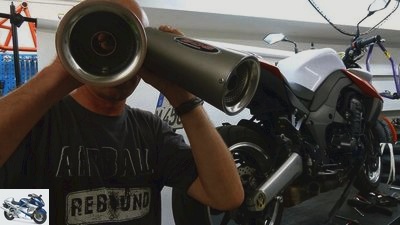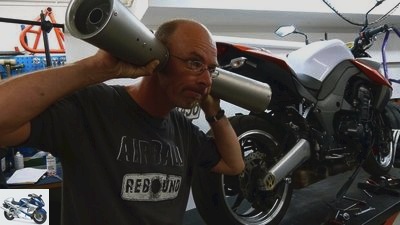Table of contents
- Euro 5 for motorcycles from 2020 First exhaust gas values, then OBD II and volume
- Exhaust gas values
- On-board diagnosis OBD II
- New legislation for volume from 2024
- Conclusion

Katrin Sdun
counselor
traffic & business
Euro 5 for motorcycles from 2020
Euro 5 for motorcycles from 2020
First exhaust gas values, then OBD II and volume
From January 1, 2020, Euro 5 will apply to all new motorcycle type approvals (including 125cc), and from January 2021 to all newly registered motorcycles. OBD II was postponed to 2024 due to major technical challenges, a new EU noise regulation is also likely to come in 2024.
Dina Dervisevic
08/22/2019
In January 2016, the Euro 4 standard came into force for motorcycles that were newly homologated. Since January 2017, the standard has applied to all motorcycles that are newly registered. For 2020, with the Euro 5, a further tightening is already in the starting blocks – first for new type approvals, i.e. new models. From 2021 onwards for all motorcycles that are newly registered. The new emissions standard for motorcycles essentially comprises two points:
1.) The reduction of exhaust emissions (Euro 5)
2.) Standards for on-board diagnosis OBD II (Euro 5b)
Exhaust gas values
To 1.): Compared to the Euro 4 requirements, the exhaust gas values have to be reduced by around a third. The transition from Euro 4 to Euro 5 is not as big a step in terms of exhaust emissions as it was back then from Euro 3 to Euro 4, explains Michael Ryland, head of motorcycle technology at Ricardo. Ricardo is an independent technology provider whose technicians have been working on the implementation of various Euro 5 specifications for years. You were also instrumental in developing the BMW six-cylinder for the K series.

Katrin Sdun
But although it should be a manageable step from Euro 4 to Euro 5, the challenges for the designers are becoming more and more complex. Because the use of relatively simple means, such as catalytic converters or switching from carburettors to injection, is no longer enough. “The task now is to find solutions that can still be technically implemented on the motorcycle and remain affordable.”
Variable control times and turbochargers can be part of this, as developments in the automotive industry make technology more and more compact and affordable. Such technical solutions are particularly obvious for sporty motorcycles, where there must be no loss of performance. In the case of smaller and mid-range motorcycles, a lot will probably be solved via the liter output. This means that the displacement increases, but the output does not increase proportionally. KTM is currently showing the way with its mid-range Duke – the 890 Duke R is already available for the 790 Duke, which will most likely be followed by an 890 Duke standard variant. In the case of Triumph, the Tiger is likely to increase from 800 to 900 cm³ and the Honda Africa Twin also competes with an enlarged displacement.
On-board diagnosis OBD II
Regarding 2.): The on-board diagnosis system is about the motorcycle itself monitoring all exhaust-related factors, such as catalytic converters and misfires. OBD II has been mandatory for cars since 1996, motorcycles are given another grace period until 2024. Originally, OBD II in motorcycles was planned for 2020, but the technical implementation is proving to be extremely difficult, which the EU Commission took as an occasion to postpone. It is not yet clear what the second stage of the Euro 5 emissions standard will be called – we simply call it the same as for the car “Euro 5b”.
New legislation for volume from 2024

Katrin Sdun
New limit values for the maximum volume of motorcycles and new measurement methods to check noise development are not planned until 2024. The regulations will not be part of the emissions standard, but separate legislation that limits the volume more effectively than the currently valid EU noise regulation UNECE-R 41.04 is likely. It is not yet clear whether it is a question of a lower driving noise limit than the current 77 dB (A) or a wider range of validity and new test procedures.
interview
Interview with Christoph Gatzweiler, who, as head of technology at the German motorcycle industry association, is involved in the negotiations between manufacturers and the EU. He is calm about the first Euro 5 level.
Euro 5 initially means an imminent, renewed tightening of exhaust gas limits. What is your impression, how do the manufacturers cope with it?
The new limit values have been known for a while, so there shouldn’t be any major problems with implementation.
Does that only apply to the big manufacturers? What about small companies or niche manufacturers like Beta or Fantic? How do custo-mizers get along? Are there exceptions to protect such minorities?
There is the EU small series with simplified regulations or national permits. Nevertheless, the new regulations for Euro 4/5 remain a real challenge, especially for smaller market participants.
Are the new Euro 5 limits the beginning of the end of air-cooled engines? We can hardly imagine purely water-cooled Harleys …
In principle, air cooling would still be technically possible, but this concept is likely to be the exception in the future.
Can you briefly explain that??
The EU regulations do not restrict the type of engine. You just set the bar. In principle, the exhaust gas behavior is also dependent on the operating temperature, which is easier to control with water cooling. But if, for example, the operating temperature of a motor does not necessarily require additional cooling, simple air cooling could theoretically also be sufficient.
What about the few two-stroke machines that are currently still around, from KTM, for example? They are dying out completely?
It is getting more and more difficult for the two-stroke, but it has already been declared dead several times and is still there! We just remain optimistic about that.
Is it already foreseeable where the noise limit values that we know will take effect from 2024 will go? Can the current driving noise limit of 77 dB (A) be significantly reduced, from a purely technical point of view?
The fact is, it won’t stay the way it is. From our point of view, however, it does not make much sense to further reduce the general noise level of 77 dB (A) significantly. It would be much more important to revise the additional requirements, which are supposed to cover a broader range of operating states. There must be a sustainable solution for this that can also be implemented by industry by 2024 or 2025.
Which means that the test procedure needs to be changed. In conclusion: Motorcyclists don’t have to worry that new machines will soon become more expensive as a result of Euro 5?
No, if the legislature does not require something completely excessive when it comes to vehicle noise, there should be no significant price increase, as with the Euro 4 level.
Conclusion
The update to Euro 5 is not as drastic as the change from Euro 3 to Euro 4. Nevertheless, the lower the values, the more difficult it is to get there. This not only poses challenges for manufacturers, but also for workshops and developers of test and measurement procedures.
Related articles
-
New registrations July 2020: most popular motorcycles
KTM 20th pictures manufacturer 1/20 First place among new motorcycle registrations in July 2020: BMW R 1250 GS with 1,253 units. New registrations from…
-
Overview Euro 4 for motorcycles
Fotolia counselor traffic & business Overview Euro 4 for motorcycles Overview Euro 4 for motorcycles Something is coming up Since the beginning of the…
-
New registrations August 2020: most popular motorcycles
manufacturer 20th pictures manufacturer 1/20 First place among new motorcycle registrations in August 2020: BMW R 1250 GS with 685 units. New…
-
These motorcycles do not pass the Euro 5 hurdle
News 2022 New motorcycle items for 2022 Aprilia. 34 pictures Aprilia. 1/34 Aprilia discontinues the Shiver 900 with Euro 5. Unfortunately. The engine…
-
New noise regulation for motorcycles from 2016
Motorcycle noise Debate about the volume of motorcycles Photo: fact 8th pictures Chaqune 1/8 Moto Guzzi driver Holger Siegel is the spokesman for the…
-
EU type approval: motorcycles, trikes, quads
fact 9 pictures Bilski 1/9 The motorcycle license is not only a permit to drive on public premises, but also for many people the ticket to freedom. To…
-
Motorcycle noise Debate about the volume of motorcycles Kesstech counselor traffic & business Euro 4 and exhaust flaps Euro 4 and exhaust flaps…
-
Bikes that are no longer available with Euro 4 in 2017
Drawing: Aue 21 pictures www.bilski-fotografie.de 1/21 Aprilia SL 750 Shiver. www.factstudio.de, Joachim Schahl 2/21 BMW K 1300 S.. Ducati 3/21 Ducati…
-
Caution, Euro 4 trap: private owners must still allow 2020
Jorg Kunstle 66 pictures Aprilia. 1/66 Aprilia Shiver 900, Euro 4, 95 hp, from 9,090 euros. Aprilia. 2/66 Aprilia Dorsoduro 900, Euro 4, 95 hp, from…
-
Most popular 48 hp motorcycles for 2020
KTM 25th pictures KTM 1/25 KTM 390 Duke with 2,277 units in first place. Jorg Kunstle 2/25 Honda CMX 500 Rebel in 2nd place with 2,037 units. Rossen…